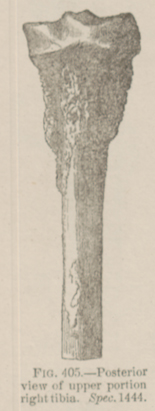Title: Sailor, J. W.
Source text: The Medical and Surgical History of the War of the Rebellion. (1861-65.), Part 3, Volume 2 (Washington, DC: Government Printing Office, 1883), 722.
Civil War Washington ID: med.d2e26884
TEI/XML: med.d2e26884.xml
CASE 1068.—Private J. W. Sailor, Co. K, 48th North Carolina, aged 23 years, was wounded in the right leg, at Hatcher's Run, March 13, 1865. He was treated in Confederate hospitals until May 6th, when he was admitted into hospital at Point Lookout. Subsequently he was transferred to Armory Square, and lastly to Douglas Hospital, Washington. Assistant Surgeon W. F. Norris, U. S. A., in charge of the latter, made the following report: "The wound was caused by a ball perforating the tibia at the upper third without involving the knee joint. The patient was cachectic and much emaciated, the wound indolent and discharging a thin unhealthy pus. Stimulants, tonics, and good nutritious diet were freely exhibited. On September 3d the wound was carefully examined and a considerable quantity of carious bone was removed. On the next day the patient had a severe chill which recurred on the 6th. He had been subject to periodical chills and fever, and this attack of intermittent yielded readily to a full dose of quinine. On September 10th slight diarrhœa came on and continued for nine days, the patient growing much weaker. The wound, which had improved in appearance after the removal of the dead bone, again looked unhealthy, small abscesses having formed along the line of the tibia, which, when opened and examined by the probe, showed extensive necrosis of the bone. Subsequently the patient had a slight chill, which was followed by an attack of erysipelas of the leg, and from this period he steadily declined. He died, apparently of exhaustion, on October 1, 1865. The autopsy showed a dirty yellowish clay color of the skin. The thoracic and abdominal organs were apparently healthy, except the liver and the spleen, the former being enlarged and the latter much softened and weighing fourteen ounces." The perforated tibia, contributed with the history by Assistant Surgeon Norris, and constituting Specimen 1444 of the Surgical Section of the Museum, exhibits the deposit of a large quantity of callus on the outside of the bone, and shows the cavity of the passage of the ball to be enlarged by ulceration, the lower portion of the shaft being superficially necrosed. Posterior and lateral views of the specimen are copied in the wood-cuts (FIGS. 405, 406).

